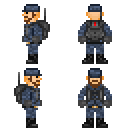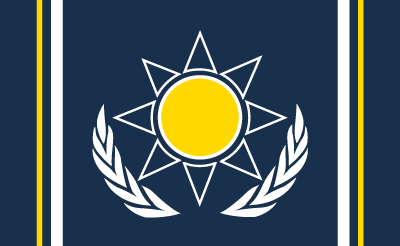Trans-Solar Federation
Summary
The Trans-Solar Federation (also known as "SolGov") is the largest originally Human government in the Galaxy. It is a military republic composed of various colonized systems within and around Sol proper.
History
After weathering a series of prolonged natural disasters and resulting resource wars that lasted from 2083-2093, the surviving nations on Earth federated to form the United Earth Confederacy--a precursor to the Trans-Solar Federation. In 2099, the Confederacy launched humanity's first extraterrestrial colonization program, known as the “Ark Program”, with Mars as its destination. In 2103, the UES Ark successfully touched down in the Holden Crater, and colonization efforts began. The confederacy was not meant to last however; internal conflict within the Confederacy played a hand in its dissolution, disrupting supply shipments and leaving the budding Martian colony in the dark. The power vacuum that was created in the wake of the Confederacy's collapse would go on to spur the disparate nations of Earth into a nuclear power struggle known as the third world war.
Following sixteen years of warfare, the Solar Federation finally emerged from the ashes of the now war-weary nations, and quickly resumed the Ark Program. Upon arrival of the first relief and resupply ship in 2128, it was quickly discovered that after the communications blackout, the Ark colony had exploded in population, size, and productivity. Using iron and carbon refined from the Martian soil they had built vast manufacturing and mining infrastructure, allowing the colony to become self-sufficient. Nanotrasen, having incorporated under the UEC just before the dissolution, already possessed the rights to a sizable amount of Mars’ planetary surface via lucrative mining, refining, and research contracts – a position they continue to hold to this day.
Spurred on by a population crisis in the Sol System, the recent discovery of Bluespace and advancements in faster-than-light transmission and thruster design, the Solar Federation was reformed into the Trans-Solar Federation (SolGov as we know it today) in the year 2199. Owing to the vast distances between stars, stations such as Naval Station Norfolk - which serves a double role as a refueling station for colonial vessels and a drydock facility for SolGov Navy ships - were constructed to further extend the reach of SolGov.
While SolGov’s power is vast, there are two notable exceptions to the body's sphere of influence within the Sol System. The large swathes of the planet Mars (Sol 4) - the historical headquarters of Nanotrasen - is typically policed by Nanotrasen, who are quite capable of policing and enforcing SolGov’s laws. As a whole, however, Mars is a vassal planet to SolGov and therefore under its purview.
The Second is the Earth’s moon (Sol 3.1), known locally as “The Moon” or “Luna.” The moon of Earth is protected under a special treaty granting it independence of Federation rule. The Port of Luna proper is administrated by Port Royal Inc. – an independent corporation which operates solely within the confines of Luna’s established boundaries.
Due to the nature of Luna’s economic zone of exclusivity, its status as a free port and its negligible taxes and fees, it has become an attractive haven for some of the wealthiest citizens in the galaxy to harbor their significant assets and holdings. Rumors abound that the CEO of Nanotrasen himself has a significant estate somewhere on Luna’s surface.
Political Structure

|
| A typical TSF soldier. |
Based in the Sol system, the Trans-Solar Federation is similar to the pre-2083 United States of America, in that it has a bicameral legislature and separate judicial and executive branches. These branches form a series of checks and balances against one another, preventing any one branch of government from acquiring too much power. They are the Executive Branch, Judicial Branch, and the Legislative Branch, the latter being made up of the Citizen's Council and Civilian Assembly. It is a militaristic form of democracy, where full citizenship can only be gained through military service. The voting franchise is limited to full citizens, and they are the only ones allowed to hold public office. Additionally, after serving with a branch of the military, citizens gain access to Federation benefits, the right to purchase voting shares, and a share in United Trans-Solar, the state mining conglomerate.
Civilians are a class of Federation members who have not served and do not actively serve within any branch of its military at any point in time. They are entitled to basic rights, but cannot hold any form of public office, or vote for their representatives; save for the Civilian Assembly, the lesser legislative body meant to represent the civilian population of the Federation. The leader of this body is the Assembly Speaker. Civilians are sometimes permitted to vote in local elections under specific circumstance and law.
The Navy controls most major transportation of Federation soldiers, citizens, and cargo within their territory, and is led by the Fleet Admiral. The Marine Corps are the fist of the Federation, used against rebellious elements or in times of war or crisis, and are led by the Chief General. The Civil Defense Corps are the planet bound armies of the Federation led by the Field Marshal, and act defensively on Federation colonies and stations. Most members of the Civil Defense Corps serve on the same planets they have been recruited from, often fighting harder when defending what they consider their own homes. The services of the three branches are vital to the daily function of the Federation, but they and their leadership are not without reproach. The Navy, Marine Corps, and Civil Defense Corps are still answerable to the Executive branch of the Federal government, as well as the Citizen’s Council which reserves the right to censure and reprimand members of the military. The Citizen’s Council also possess the sole ability to issue a Declaration of War, as well as declare an Edict of Force; ordering the deployment of the Navy & Marine Corps to a specific end. Both of these actions must be passed with a majority and be approved by the First Citizen, as well as be signed by the President to become valid, unless such a declaration or edict is ruled by the Chief Justice to be contrary to the Federal Charter.
Rebellions
Despite its power, The Federation has had multiple rebellions and splinter groups. The latter, so long as they continue to pay taxes and keep to themselves, are generally ignored by the massive bureaucratic processes. Rebellions, on the other hand, are met with the government's full and undivided attention.
The largest, and most robust rebellion against The Federation occurred in 2443 when the Cygni system’s populace engaged in the wholesale slaughter of all federal personnel aboard Naval Station Oahu, resulting in 5,310 military casualties. The Oahu Massacre, as it was later deemed, was quickly followed by a Declaration of War and Independence by the Cygni system governor, Malfoy Ames. Upon transmitting these declarations, he reformed the Cygni government into the Union of Soviet Socialist Planets. This prompted the largest mobilization of human military might since World War III. An armada of 105 vessels arrived in the Cygni system, quickly crushing the meagre defenses of the USSP rebels, resulting in the destruction of Naval Station Oahu, 15 captured SolGov vessels, and 6 USSP-flagged gunships. Upon arrival at Cygni Prime, a declaration was put out by the SolGov Navy; The people of Cygni Prime would evacuate the planet immediately, or be killed in the ensuing nuclear bombardment that would take place three days later. Millions of souls were evacuated in the course of those three days, causing a massive refugee crisis in neighboring systems within jump range of the civilian vessels, and SolGov official estimates suggested that as many as 760,000 civilians died in the nuclear fire that followed.
This application of overwhelming force mitigated the need for a protracted planetary siege and engagement strategy, allowing SolGov to quickly and effectively re-establish their dominance over the Cygni system. Holdout loyalist groups would eventually coalesce in various sectors just outside SolGov’s reach, building stations that proudly bore the flag and language of the USSP. Many of these stations were later abandoned, thanks to substandard construction materials and techniques, but a few of these stations were destroyed by an unknown, hostile, and nuclear-capable force.
